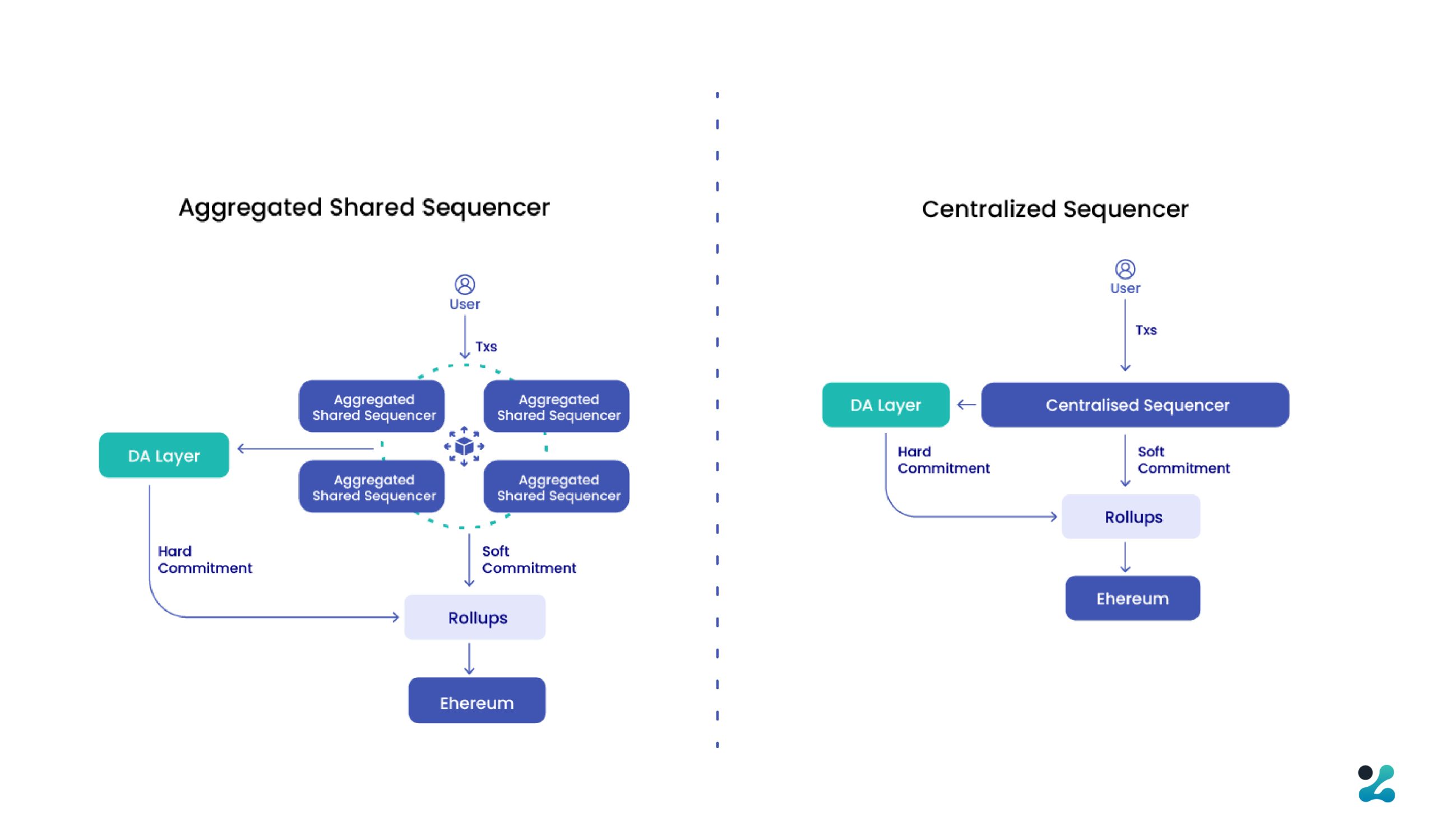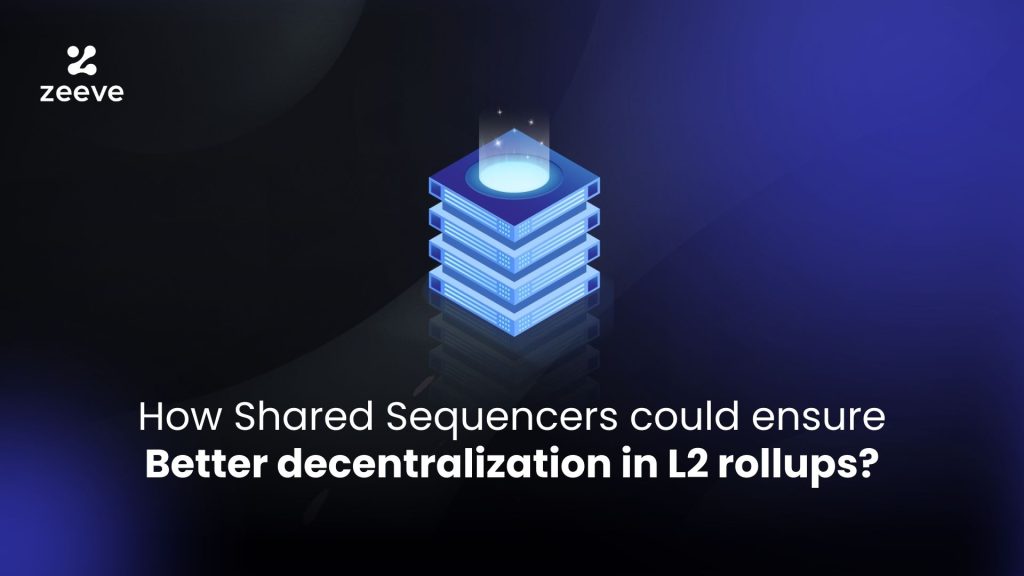Most rollups today, even many leading Ethereum L2s, use centralized sequencers. Though it has its own benefits in terms of efficiency and cost, it might not suit the needs of many new rollups settling on Ethereum because of MEV attacks, liquidity fragmentation, and interoperability barriers diluting decentralization.
If projects want to maintain sovereignty and security occurring simultaneously, shared sequencing is a good way forward because it helps projects maintain decentralization without affecting security, performance, or cost. In this piece, we shall see how their role will be imminent in the future of L2/modular chains.
What are Shared Sequencers?
Sequencers do the job of transaction ordering. Unlike a centralized sequencer, which can be censored by its own protocols or an external force, a shared sequencer is a rollup agnostic network capable of serving different rollup chains simultaneously for sequencing their transactions.
Due to their distributed nature, shared sequencers sound more like heavily distributed L1 validators. They can easily withstand a high degree of censorship and network downtime, aka non-liveness.
How Do They Work?
The shared sequencer abstracts the function of execution through a shared aggregated sequencing layer that accepts transactions from all the modular rollup chains and aggregates them for execution through a sequencer node that is chosen democratically through voting.
As a result of such a practice, concentrated decentralization is maintained because, unlike a single sequencer for the rollup chain, shared sequencing for rollups eliminates chances of censorship, MEV extraction, and service denial.
The aggregated sequencing layer/node establishes communication among all the rollup sequencers through ROLL API / JSON-RPCs so they can jointly vote and agree to the transaction ordering while sequencing the blocks. Moreover, it also aids in inter-rollup chain communication to eliminate liquidity fragmentation. The time-lapsed proof for sequencing the transactions eliminates the chances of reorg that a single sequencer might practice for extracting maximum value from transactions.
Thereby keeping the rollup execution environment decentralized like the base L1 chain.
The image given below will help you understand how the execution changes on a modular rollup chain through a shared sequencer;

When there’s a single sequencer for a rollup, they have full control over arranging the transactions for maximum gains or, in the worst case, even censoring them. However, when shared sequencing for rollups occurs, the dynamics change in the following ways.
Transactions from the rollup chains are landing on the agg. sequencing layer that triggers execution through consensus-based voting to choose a sequencer for validating the block. The sequencer gets the chance to validate transactions through an order engine that follows the rules of L1 to arrange the transactions. Therefore, the control from a single sequencer is diluted. On the contrary, all the connected chains and their validators/sequencers will observe the transaction and provide a consensus to be included for sequencing from the agg.sequencing chain for settlements on rollups.
Hence, a single sequencer’s control over the network is diluted, making all the chains interconnected with the same sequencer set decentralized. The transactions are included in the block only after the L1 chain has accepted the proof of the bundled transaction from the sequencer for all the subsequent modular rollup chains. It uses the aggregated sequencing layer to sequence the transactions from their rollup chains for settlements.
How Do They Solve the Problem Left by Centralized Sequencers?
Centralized sequencers have created multiple problems:
- Monopoly
Monopoly is a key problem in centralized sequencers. For context, the Base Blockchain has Coinbase as its sequencer, which is roughly making $30 million in revenue by sequencing the transaction independently. Now, when there is just a single sequencer, the users are at their mercy to include or omit the transaction. If the users want to get their transactions recorded in the block, they will have to look for an escape hatch route that allows posting on the L1 chain directly, but such an approach is very expensive for the user.
In such a situation, the centralized sequencer will level up its transaction price at par with the escape hatch. Now, either the user can choose the escape hatch to post their transaction on L1 or use the L2 sequencers. Since the L2 sequencers are closely interconnected with other Dapps in their ecosystem, their users will be forced to use the L2 centralized sequencers in any way.
- Censorship
When centralized sequencers arrange user transactions, they can reject the transaction at will. What if such a situation occurs with governance votes? If the centralized sequencers pass an order and do not let any unfavorable vote counts be included in the consensus for execution, it could lead to panic within the ecosystem and completely bring the chain to a halt.
Decentralized/shared sequencers on rollups solve this by;
Introducing Leader Rotation
In a leader rotation round-robin format, an election will be held to choose who gets to vote for sequencing the transaction and including it in the block. Such a practice will eliminate the threat of denial of service or triggering excessive MEV while sequencing the transaction.
Furthermore, though the chosen sequencer for that respective block will have complete control, he/she will have no control over the rollup chains for other blocks, where he/she can tamper with the transaction in a manner that benefits them.
Such a practice significantly impacts the urge to compromise the rollup sequencer ecosystem for profit motives because the sequencer will have control over a single block. If he/she wishes to change the respective block, it must match with the nonce of the previous block arranged, or else it will be rejected.
Consensus Through BFT and BLS
In this model, the chosen sequencer who has been responsible for sequencing the transaction in order and arranging the same in the block will have to seek approval from all the other sequencers active on the sequence agg layer. The process must be completed even before the block header has been broadcasted. Otherwise, the sequencer will lose the chance to sequence the transaction, and a new election will be held to choose the sequencer for sequencing and including the transaction in the block.
A BFT consensus will be used where 66.66 or 1/3rd of the sequencers must vote for sequencing the transaction. Simultaneously, a BLS or Block Ledger Signing will be in progress, and the sequencer will have to incur a fee for sequencing the transaction through a BLS signature. If any sequencer wishes to collude, not only will he/she be removed from the voting group, but he/she will also have to incur fees for signing the transaction sequencing through BLS, which would be going in vain.
Furthermore, since the sequencer will have to sign the transaction sequenced to be included in the block through a BLS for batch signing and there will be competition among sequencers to arrange and sign the transaction, any delay would significantly increase the BLS cost, eliminating the need to look for better transactions for inclusion to obtain maximum revenues.
Top Decentralized Sequencers For Rollups
NodeKit
NodeKit introduces a new model for creating decentralized shared sequencers, separating the proposers and builders to attain cross-chain atomicity.
The key tradeoff of using NodeKit’s SaaS will be accessing a wider rollup ecosystem through a single SEQ L1 API connecting all the rollup networks as one and simplicity of deployment on Optimism rollup chain through a Sandbox SDK for now.
In this way, through shared sequencing for rollups, NodeKit will allow different modular chains to set up their own decentralized shared sequencer set without having to deploy a sequencer earmarked for their own chain, which is extremely cost-intensive and a less secure way to onboard new users on your ecosystem.
Astria
Astria, a middleware-shared sequencer, will use Celestia for hard commitments. The trade-off of using Astria as a decentralized sequencer for rollups will be to maximize the time finality because the rollups will see Astria’s sequenced block as soft commitments to Celestia. So, they have the discretion to either choose from a hard commitment of 11 seconds for Celestia block or a 1-second soft commitment on Astria for faster settlements without compromising the decentralization and scalability of the rollup chain.
Radius
Radius is another noteworthy name to use when looking for a reliable SaaS for your rollups because they have introduced PVDE or Practical Verifiable Delay Encryption.
The trade-off of PVDE is that since centralized sequencers have been allegedly stealing the MEVs from the rollup chains, PVDE acts as an off-setter for the perpetrators because they cannot see the contents of the transactions because they are encrypted and hidden. In this way, it protects the users from exploitation at the hands of centralized sequencers.
Build Your Rollup with Shared Sequencers on Zeeve RaaS
Zeeve RaaS has a solid ecosystem of integration partners, including all the leading shared sequencing service providers, such as NodeKit and Radius. These integrations are available as an easily pluggable component when deploying your L2/L3 rollups with Zeeve Rollups-as-a-Service.
Choose your rollup framework, such as OP Stack, Arbitrum Orbit, Polygon CDK, or zkSync ZK Stack, and launch your rollup with all middleware, such as block explorers, faucets, cross-chain bridges, indexers, etc. Then, as needed, you can choose the integrations you might need, such as Sequencers, provers, DA layers, account abstraction SDKs, and more, right from day 1.
To start your rollup journey, visit the Rollups-as-a-Service page. Have further queries? Schedule a call with our experts, and we can help you figure out what might suit your needs better.





